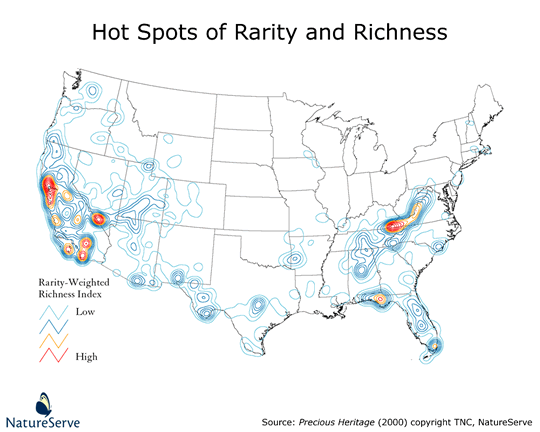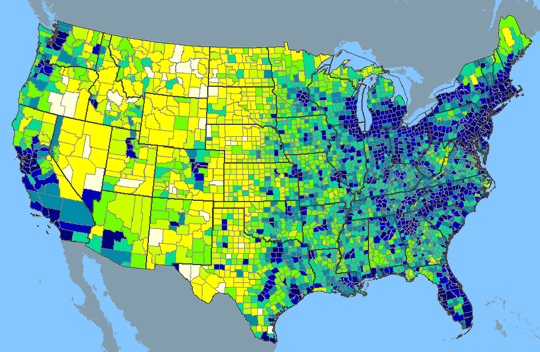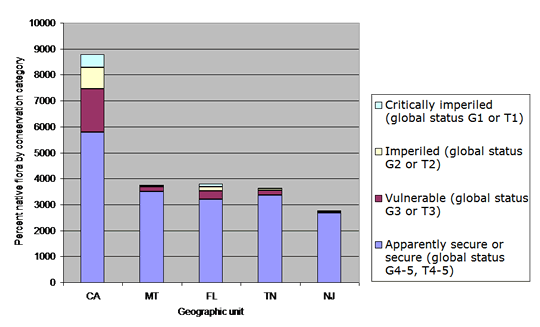USDA Forest Service Celebrating Wildflowers
|
|
|
How Many Rare Plants Are There?To calculate the number of rare plants in the United States, it is obvious that we need a definition of exactly what we mean by "rare." Less obvious, perhaps, is the additional need to define what we mean by "plant." For our purposes, we define "rare" using NatureServe’s conservation status ranks. Combining the categories of critically imperiled, imperiled, and vulnerable for species, subspecies, and varieties - this equates to ranks G1-G3 and T1-T3 - gives us our definition of "rare." So what does "plant" mean to us? Trees, shrubs, vines, and wildflowers are plants. So are ferns, mosses, and horsetails. Contrary to popular belief, fungi and lichens are NOT plants. However, we will include them in our plant tally because Forest Service botanists are usually responsible for day-to-day conservation of these organisms on national forest lands, and because most people think of lichens and fungi as more closely related to plants than to animals. Some parts of the United States are hotspots for plant diversity and plant rarity. Most often, the largest numbers of rare plants are in places where there is both great plant diversity (meaning more species per unit of area) and large human populations. Look at the maps below and you will see the pattern. The map of hotspots is from the book Precious Heritage, The Status of Biodiversity in the United States, published by Oxford University Press in 2000 (Figure 1). Using these definitions of "rare" and "plant", there are 8,840 rare plants in the United States of America, or approximately one-third of the total native U.S. flora. Rare plants are distributed unevenly across the landscape (Figure 1), resulting in a few spots of unusually high overall floristic diversity and higher than usual numbers of rare plants (see Why are some plants rare?). From this map, you can see that California, Florida, and the Appalachian Mountains are diversity hotpots, while the Plains and northern states have fewer species.
For more information about biological hotspots of the United States, visit the Smithsonian Institute’s website. Humans also are distributed unevenly across the landscape (Figure 2). Darker blue shows the densest population centers, while yellow and white are sparsely populated locations.
Where dense populations of people share the same landscape with hot spots of rarity and species richness, the result is higher than average numbers of plants at risk of extinction. Compare several states as examples (Table 1 and Figure 3).
First, compare California and Montana, both large states in the western United States. California is a hotspot of diversity AND is heavily populated. California has both a large total flora (8,779) and a high proportion of rare species in all three categories of rarity: vulnerable, imperiled, and critically imperiled. Montana, on the other hand, has a much smaller total flora, a small proportion of rare plants, and very few rare plants in the critically imperiled category. In addition to species richness and human population, a third factor at play is that California’s flora is largely unique to California, while much of Montana’s flora extends north into Canada, west into the Pacific Northwest, south along the Rockies, and east into the Great Plains. Plants with wide geographic distributions tend to be less rare and less vulnerable than plants with narrow ranges. Florida and Tennessee have similar overall species richness. Florida has twice the number of rare plants, including many more in the critically imperiled and imperiled categories, perhaps related to the intense development pressure in parts of Florida and the fact that much of Florida’s flora is unique to Florida. New Jersey, the most densely populated state, has a rich native flora for its size, but its flora is shared with adjacent states, and New Jersey has relatively few rare plants. How many of our nation's 8,840 rare plants are protected under the Endangered Species Act (ESA)? Only 764, or 9 percent, are listed under ESA. Of the 764 listed rare plants, 125 are known to occur on our national forests and grasslands. You can find a profile for each of these listed plants on this website. If you want to find out how many rare plants are in your state, visit the NatureServe encyclopedia of life, and use the advanced search features. |
|||||||||||||||||||||||||||||||||||||
| NOTE: PDF format links require the Adobe Acrobat Reader to view. | |||||||||||||||||||||||||||||||||||||
| top | Disclaimers | FOIA | Privacy Policy | Quality of Information | Photo Credits & Use |
Location: http://www.fs.fed.us/wildflowers/rareplants/howmany.shtml
Last modified: Friday, 16-May-2008 13:44:51 EDT


